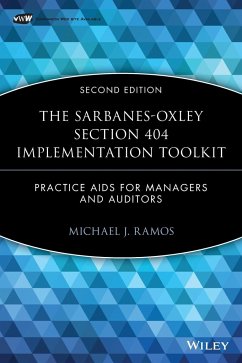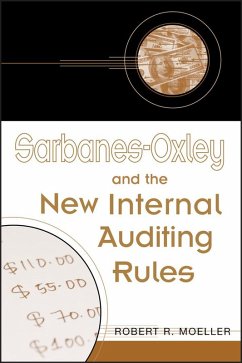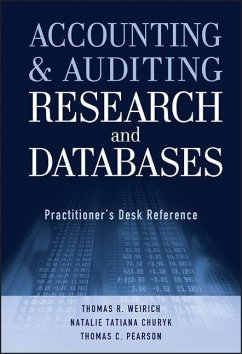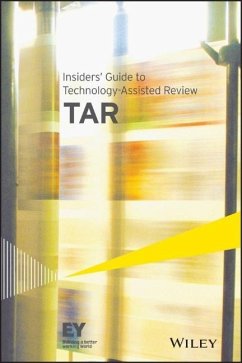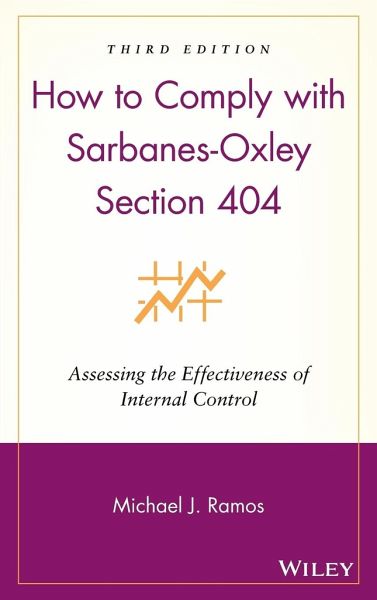
How to Comply with Sarbanes-Oxley Section 404
Assessing the Effectiveness of Internal Control

PAYBACK Punkte
49 °P sammeln!
Fully revised and updatedA step-by-step approach for planning and performing an assessment of internal controlsThoroughly revised and updated, How to Comply with Sarbanes-Oxley Section 404, Third Edition brings practical clarity to a complex topic, providing a comprehensive, logically structured approach to effective testing and evaluation of internal controls within your company. Informative and clear, this refreshingly readable book demonstrates author Michael Ramos's deep understanding of the technical 404 requirements and contains the most pertinent updates and important SEC and PCAOB rele...
Fully revised and updated
A step-by-step approach for planning and performing an assessment of internal controls
Thoroughly revised and updated, How to Comply with Sarbanes-Oxley Section 404, Third Edition brings practical clarity to a complex topic, providing a comprehensive, logically structured approach to effective testing and evaluation of internal controls within your company. Informative and clear, this refreshingly readable book demonstrates author Michael Ramos's deep understanding of the technical 404 requirements and contains the most pertinent updates and important SEC and PCAOB releases.
The Third Edition helps CFOs, auditors, corporate managers, and consultants knowledgably interpret and conform to Sarbanes-Oxley Section 404 compliance and features:
_
Clear, jargon-free coverage of the Sarbanes-Oxley Act and how it affects you
_
Examples and action plans providing blueprints for implementing requirements of the Act
_
Easy-to-understand coverage of the requirements of SEC, PCAOB, and COSO guidance
_
Discussion of the requirements for assessing internal control effectiveness
_
A look at how the new guidance will reduce your costs
_
In-depth explanations to help professionals understand how best to approach the internal control engagement
_
Practice aids, including forms, checklists, illustrations, diagrams, and tables
This area of auditing and corporate governance will continue to evolve and bring about business and cultural change. How to Comply with Sarbanes-Oxley Section 404, Third Edition is your must-have, must-own guide to SOX 404 implementation and an effective tool and reference guide for every corporate manager.
A step-by-step approach for planning and performing an assessment of internal controls
Thoroughly revised and updated, How to Comply with Sarbanes-Oxley Section 404, Third Edition brings practical clarity to a complex topic, providing a comprehensive, logically structured approach to effective testing and evaluation of internal controls within your company. Informative and clear, this refreshingly readable book demonstrates author Michael Ramos's deep understanding of the technical 404 requirements and contains the most pertinent updates and important SEC and PCAOB releases.
The Third Edition helps CFOs, auditors, corporate managers, and consultants knowledgably interpret and conform to Sarbanes-Oxley Section 404 compliance and features:
_
Clear, jargon-free coverage of the Sarbanes-Oxley Act and how it affects you
_
Examples and action plans providing blueprints for implementing requirements of the Act
_
Easy-to-understand coverage of the requirements of SEC, PCAOB, and COSO guidance
_
Discussion of the requirements for assessing internal control effectiveness
_
A look at how the new guidance will reduce your costs
_
In-depth explanations to help professionals understand how best to approach the internal control engagement
_
Practice aids, including forms, checklists, illustrations, diagrams, and tables
This area of auditing and corporate governance will continue to evolve and bring about business and cultural change. How to Comply with Sarbanes-Oxley Section 404, Third Edition is your must-have, must-own guide to SOX 404 implementation and an effective tool and reference guide for every corporate manager.



